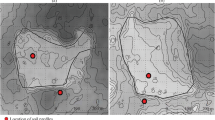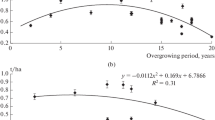Abstract
Processes of initial soil formation were studied on long-term monitoring plots on dump rocks of quarry no. 3 of the Phosphorite production company in Kingisepp district of Leningrad oblast. Observations were performed in 1998, 2004, and 2014. It was shown that vegetation succession on the plots proceeds relatively quickly, and that the species composition of phytocenoses formed is typical of the areas with soddy-calcareous soils. Soil development proved to be correlated with the development of vegetation. Maximum changes in soil characteristics were observed with an increase in the density of forest vegetation and a decrease in the role of herbs. The molecular composition of humic acids in the studied soils remained stable; in particular, the ratio of aliphatic to alkyl aromatic fragments was virtually constant. This phenomenon could be due to the great amount of aliphatic components in the falloff of coniferous species subjected to humification.
Similar content being viewed by others
References
E. V. Abakumov and E. I. Gagarina, “Humus formation in carbonate soils of the quarry-dump complexes in the northwest of the Russian Plain,” Vestn. S.-Peterb. Univ., Ser. 3: Biol. 1 (3), 67–75 (2002).
E. V. Abakumov and E. I. Gagarina, Pedogenesis in Post-Technogenic Ecosystems of the Quarries in the Northwest of the Russian Plain (St. Petersburg State Univ., St. Petersburg, 2006) [in Russian].
L. N. Aleksandrova, Soil Organic Matter and Its Transformation (Nauka, Leningrad, 1980) [in Russian].
N. D. Ananyeva, E. A. Susyan, and E. G. Gavrilenko, “Determination of the soil microbial biomass carbon using the method of substrate-induced respiration,” Eurasian Soil Sci. 44, 1215–1221 (2011).
I. B. Archegova, “Relation of humus with nontraditional understanding of soil,” Pochvovedenie, No. 1, 58–64 (1992).
I. B. Archegova, Efficient System of Nature Recovery as the Basis for Nature Management in the Extreme North (Komi Scientific Center, Ural Branch, Russian Academy of Sciences, Syktyvkar, 1981), No. 412.
I. B. Archegova, E. G. Kuznetsova, F. M. Khabibullina, I. A. Likhanova, and A. N. Panyukov, “Accelerated recovery of disturbed northern territories: theoretical and applied aspects,” Mezhd. Zh. Prikl. Fundam. Issled., No. 8-2, 204–206 (2013).
V. S. Ipatov and L. A. Kirikova, Phytocenology (St. Petersburg State Univ., St. Petersburg, 1997) [in Russian].
L. P. Kapel’kina, “Reclamation of disturbed lands in Leningrad oblast,” Reg. Ekol., No. 3-4 (32), 105–110 (2011).
I. O. Kechaikina, A. G. Ryumin, and S. N. Chukov, “Postagrogenic transformation of organic matter in soddy-podzolic soils,” Eurasian Soil Sci. 44, 1077–1089 (2011).
E. D. Lodygin, V. A. Beznosikov, and E. V. Vanchikova, “Functional groups of fulvic acids from gleyic peaty-podzolic soil,” Eurasian Soil Sci. 34, 382–386 (2001).
O. G. Rastvorova, Soil Physics: Manual (Leningrad State Univ., Leningrad, 1983) [in Russian].
N. S. Sekretareva, Vascular Plants of Russian Arctic and Adjacent Areas (Nauka, Moscow, 2004) [in Russian].
M. V. Semenov, E. V. Stolnikova, N. D. Ananyeva, and K. V. Ivashchenko, “Structure of the microbial community in soil catena of the right bank of the Oka River,” Biol. Bull. 40, 266–274 (2013).
I. Kh. Izbek, “Development and decomposition intensity of the roots in the depth of reclaimed soils,” Pochvovedenie, No. 9, 1132–1136 (1995).
A. B. Umarova, T. V. Beketskaya, and S. V. Zhelezova, “Transformation of physical and chemical properties of the model soils affected by wood vegetation,” Vestn. Orenburg. Gos. Univ., No. 6, 629–632 (2009).
Flora of Leningrad Oblast, Ed. by B. K. Shishkin (Leningrad State Univ., Leningrad, 1955), No. 1.
Flora of Leningrad Oblast, Ed. by B. K. Shishkin (Leningrad State Univ., Leningrad, 1957), No. 2.
Flora of Leningrad Oblast, Ed. by B. K. Shishkin (Leningrad State Univ., Leningrad, 1961), No. 3.
Flora of Leningrad Oblast, Ed. by B. K. Shishkin (Leningrad State Univ., Leningrad, 1965), No. 4.
J. Frouz, X. Li, A. Brune, V. Pizl, and E.V. Abakumov, “Effect of soil invertebrates on the formation of humic substances under laboratory conditions,” Eurasian Soil Sci. 44, 893–896 (2011).
N. N. Tsvelev, Guide for Identification of Vascular Plants of the Northwestern Russia: Leningrad, Pskov, and Novgorod Oblasts (Saint Petersburg State Chemical Pharmaceutical Academy, St. Petersburg, 2009) [in Russian].
S. N. Chukov, Structural and Functional Parameters of Soil Organic Matter under Anthropogenic Impact (St. Petersburg State Univ., St. Petersburg, 2001) [in Russian].
E. V. Abakumov, E. I. Maksimova, A. V. Lagoda, and E. M. Koptseva, “Soil formation in the quarries for limestone and clay production in the Ukhta region,” Eurasian Soil Sci. 44, 380–385 (2001).
E. V. Abakumov, O. Trubetskoj, D. Demin, L. Celi, C. Cerli, and O. Trubetskaya, “Humic acid characteristics in podzol soil chronosequence,” Chem. Ecol. 26, 59–66 (2010).
J. P. E. Anderson and K. H. A. Domsch, “Phisiological method for the quantitative measurement of microbial biomass in soils,” Soil Biol. Biochem. 10 (3), 215–221 (1978).
R. Artinger, T. Rabung, J. I. Kim, S. Sachs, K. Schmeide, and K. H. Heise, “Humic colloid-borne migration of uranium in sand columns,” J. Contam. Hydrol. 58 (1–2), 1–12 (2002).
G. Barancikova, N. Senesi, and G. Brunetti, “Chemical and spectroscopic characterization of humic acids isolated from different Slovak soil types,” Geoderma 78, 251–266 (1997).
E. Breit-Maier and W. Voellter, 13C NMR Spectroscopy (Verlag Chemmie, Weinheim, 1974).
G. D. Browen and A. D. Rovira, “The rhizosphera and its management to improve plant growth,” Adv. Agron. 66, 1–102 (1999).
B. Chefetz, “Structural components of humic acids as determined by chemical modifications and carbon-13 NMR, pyrolysis-and thermochemolysis-gas chromatography/mass spectrometry,” Soil Sci. Am. J. 66, 1159–1171 (2002).
M. Claussen, V. Brovkin, and A. Ganopolski, “Biogeophysical versus biogeochemical feedbacks of large-scale land cover change,” Geophys. Res. Lett. 28 (6), 1011–1014 (2001).
A. Golchin, J. A. Baldock, P. Clarke, T. Higashi, and J. M. Oades, “The effects of vegetation and burning on the chemical composition of soil organic matter of a volcanic ash soil as shown by 13C NMR spectroscopy. II. Density fractions,” Geoderma 76 (3–4), 175–192 (1997).
P. G. Hatcher, M. Schnitzer, L. W. Dennis, and G. E. Maciel, “Aromaticity of humic substances in soils,” Soil Sci. Soc. Am. J. 45, 1089–1093 (1981).
A. C. Kennedy, “The rhizosphera and spermosphera,” in Principles and Applications of Soil Microbiology (Prentice Hall, New Jersey, 1998), pp. 389–407.
H. R. Kleb and S. D. Wilson, “Vegetation effects on soil resource heterogeneity in prairie and forest,” Am. Nat. 150 (3), 283–298 (1997).
B. Kříbek, M. Strnad, Z. Boháček, et al., “Geochemistry of Miocene lacustrine sediments from the Sokolov Coal Basin (Czech Republic),” Int. J. Coal Geol. 37, 207–233 (1998).
J. Lichter, “Primary succession and forest development on coastal Lake Michigan sand dunes,” Ecol. Monogr. 68, 487–510 (1998).
R. B. Newman and K. R. Tate, “Soil phosphorus characterization by 31p nuclear magnetic resonance,” Commun. Soil Sci. Plant Anal. 11 (9), 835–842 (1980).
G. Ogner, “The [13C] nuclear magnetic resonance spectrum of a methylated humic acid,” Soil. Biol. Biochem. 11, 105–108 (1979).
M. Patel and S. D. Wilson, “Root dynamics and spatial pattern in prairie and forest,” Ecology 83 (5), 1199–1203 (2002).
K. Řehounková and K. Prach, “Spontaneous vegetation succession in disused gravel-sand pits: role of local site and landscape factors,” J. Veg. Sci. 17, 493–500 (2006).
A. D. Rovira, “Plant root exudates,” Bot. Rev. 35 (1), 35–37 (1969).
A. G. van der Valk, “Establishment, colonization, and persistence,” in Plant Succession—Theory and Prediction (Chapman and Hall, London, 1992).
F. Vila, J. Lentz, and H. Ludemann, “FT-C13 nuclear magnetic resonance spectra of natural humic substances,” Biochem. Biophys. Res. Commun. 72, 1063–1070 (1972).
E. A. Webster, J. A. Chudek, and D. W. Hopkins, “Carbon transformations during decomposition of different components of plant leaves in soil,” Soil Biol. Biochem. 32, 301–314 (2000).
M. A. Wilson, “Applications of nuclear magnetic resonance spectroscopy to the study of the structure of soil organic matter,” J. Soil Sci. 32, 167–186 (1981).
S. D. Wilson and H. R. Kleb, “The influence of prairie and forest vegetation on soil moisture and available nitrogen,” Am. Midl. Nat. 136 (2), 222–231 (1996).
W. Zech, M.-B. Johansson, L. Haumaier, and R. L. Malcolm, “CPMAS 13C NMR and IR spectra of spruce and pine litter and of the Klason lignin fraction at different stages of decomposition,” J. Plant Nutr. Soil Sci. 150, 262–265 (1987).
Author information
Authors and Affiliations
Corresponding author
Additional information
Original Russian Text © Ya.A. Dmitrakova, E.V. Abakumov, 2018, published in Pochvovedenie, 2018, No. 5, pp. 630–640.
Rights and permissions
About this article
Cite this article
Dmitrakova, Y.A., Abakumov, E.V. Restoration of Soils and Vegetation on Reclamation Sites of the Kingisepp Phosphorite Field. Eurasian Soil Sc. 51, 588–597 (2018). https://doi.org/10.1134/S1064229318050022
Received:
Published:
Issue Date:
DOI: https://doi.org/10.1134/S1064229318050022




